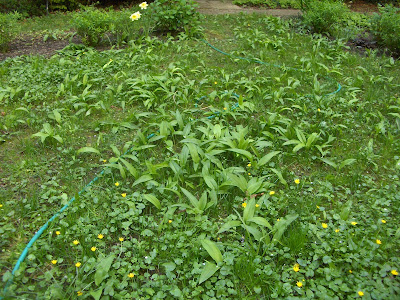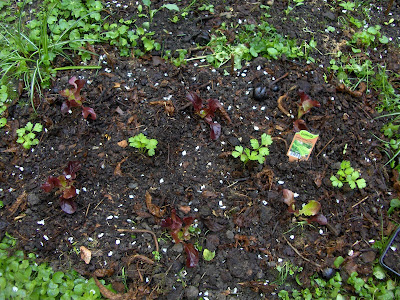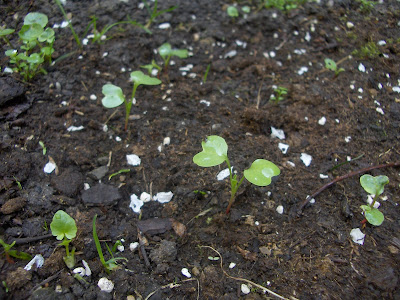Now we have planted diverse mini plants and also seeds.
We have now: rucula, lettuce, chicory radicchio, spinach, beet greens, beet roots, carrots, radish, turnips, kohl-rabi, leeks, celery, root parsley, potatoes, brocculi, peas, chickpeas, fava beans, tomatoes (still inside), peppers (still inside), courgettes, cucumber (still inside), coriander, strawberries, and of course, wild flowers for bees and butterflies, our beautiful wildlife.
Everything is still small and sprouting, since we had snow about two weeks ago.
And species less common such as tiger nuts, salsify, chinese artichokes, jerusalem artichokes, ginger root, black radish, lots of wild garlic (it grows as a weed), strawberry spinach and black potatoes.
Our approach includes
no-dig beds (Permaculture inspired), some biodynamic experimenting, and also some seed mixes thrown at the soil to see what happens (Fukuoka and Sepp Hozler inspired). Everything occupies just about 20 square meters of the whole garden.

One part of the garden with no-dig raised beds for vegetables

Wild garlic, a delicious edible wild herb, grows all around the garden

Every day there are more and more spring flowers...

Raised bed containing lettuce and brocculi. We have created this by placing sheets of newspaper, followed by 5cm rotten leaves and then 10 cm compost.

Raised bed with lettuce and celery, companion planting is the best. Wild flowers were also sown in between.

To attract beneficial insects, bees and butterflies, flowers are planted between the vegetables rows. It also creates a beautiful abundance of colour!

Radich sprouting. This was done with no raised bed, just with compost. Of course, the weeds grow again. So we decide now to just plant in raised beds!

Fast-growing courgettes (zuchinni), which will later fall down the container, now full of compost! To avoid slugs we have today put a plastic barrier (made from a cut plastic bottle) and also some hair inside. It works perfectly. Mulching will go around this.

Peas already growing for a month. These were pre-grown in small containers before. Unfortunely, peas that were planted in soil, even after overnight soaking, failed to grown properly due to slugs. We have now decided that it is best to grown all these tender vegetables (like peas, courgettes or brocculi) first in containers.

Cucumbers seedlings growing inside house, in a very warm south-oriented window! They grow fantastically fast!
Yesterday it was also such a
romantic moment
There was this piano playing in a nearby house, the apple tree leaving all its flower petals falling with a warm wind blowing while during a few times some thunder was heard.
What a beautiful spring day after one hour of veggies planting!
